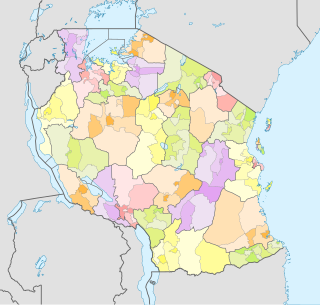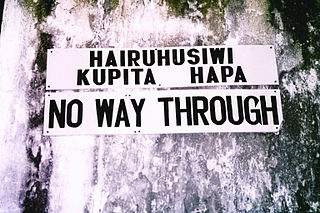Related Research Articles

Swahili, also known by its local name Kiswahili, is a Bantu language originally spoken by the Swahili people, who are found primarily in Tanzania, Kenya, and Mozambique. Estimates of the number of Swahili speakers, including both native and second-language speakers, vary widely. They generally range from 60 million to 150 million; with most of its native speakers residing in Tanzania.

Tanzania is administratively divided into thirty-one regions.

Mwanza Region is one of Tanzania's 31 administrative regions, covering a total land area of 25,233 km2 (9,743 sq mi). The region is comparable in size to the combined land area of the nation state of North Macedonia. Mwanza Region is bordered to the north through Lake Victoria by the Kagera Region and Mara Region, to the east by Simiyu Region, to the south by the Shinyanga Region and to the west by Geita Region. The regional capital is the city of Mwanza. According to the 2022 national census, the region had a population of 3,699,872 and national census of 2012 had 2,772,509. Mwanza Region is the second region with high population in Tanzania after Dar es Salaam Region.

As of 2021, there are 31 regions of Tanzania which are divided into 184 districts.
Gogo is a Bantu language spoken by the Gogo people of Dodoma Region in Tanzania. The language is spoken throughout Dodoma Region and into the neighbouring district of Manyoni.
The Sumbwa are Bantu group native to Bukombe District, Geita Region in central Tanzania. In 1987 the Sumbwa population was estimated to be 191,000. Sumbwa is a tribe that has had its own traditions and good practices. One of their traditional dance is mulekule.
The Kahe is an ethnic and linguistic group based southeast of Moshi in Kilimanjaro Region Tanzania. The Kahe language, or Kikahe, is in the Chagga cluster of Bantu languages. Three dialects are recognized: Kimwangaria, Msengoni and Kichangareni. Kikahe is spoken by 9,130 people, and is one of the smaller language communities in Tanzania.
Gweno is a Bantu language spoken in the North Pare Mountains in the Kilimanjaro Region of Tanzania. The people known as the Gweno are a Chaga ethnic and linguistic group. Since the Chaga people are Bantu speakers, the adopted language contains dialects similar to that of the Kenyan language Kamba. Gweno shares about 54% to 56% of its vocabulary with other Chaga dialects and 46% with Taita dialects. However, a large percentage of its vocabulary is not seen in the other dialects. Also at the start of the 11th century, the Chaga people descended and migrated from the Bantu group in which they migrated to the foothills of mount Kilimanjaro. The Gweno language is today spoken mostly by older adults, with younger generations having shifted to Asu and Swahili. Ethnologue considers Gweno to be moribund; the language is not being passed down because children have not been exposed to Gweno since the 1970s. The generational shift from Gweno to either Asu or Swahili has certainly created shifts in dialect, however Gweno speakers do not see this as a threat.

Geita District is located in the Geita Region of Tanzania. According to the 2022 census, the population of the district was 1,035,214. The district is bordered to the east by Mwanza Region and Nyang'hwale District, to the south by Shinyanga Region and Mbogwe District, and to the west by Chato District.

State University of Zanzibar (SUZA) is a public university located in Mbweni ward of Mjini District in Mjini Mgaharibi Region of Unguja Island in Zanzibar, Tanzania. The university was established by an act of House of Representatives of Zanzibar in 1999 and became operational in 2002.
Swahilization or Swahilisation refers to one of two practices:

Tanzania is a multilingual country. There are many languages spoken in the country, none of which is spoken natively by a majority or a large plurality of the population. Swahili and English, the latter being inherited from colonial rule, are widely spoken as lingua francas. They serve as working languages in the country, with Swahili being the official national language. There are more speakers of Swahili than English in Tanzania.
Sumbwa is an Eastern Bantu language, classified as F.23 by Malcolm Guthrie (1948). According to this classification, the language is assumed to be related to Kinyamwezi, Kisukuma, Kinilamba, Kirimi and other languages of Zone F (Guthrie 1948; 1967-71, although Nurse and Philippson 1980 and Maselle suggested that the language has had much influence from neighbouring languages. Quick inspection of the vocabulary shows that Sisumbwa appears to be closer to Nyamwezi than to any other language in the group. In terms of contacts, Sisumbwa speakers say that for a long time they have been in contact with speakers of Kisubi, Kirongo and Kizinza and Kiha, in addition to Kinyamwezi and Kisukuma.

Geita Region is one of Tanzania's 31 administrative regions. The region covers an area of 20,054 km2 (7,743 sq mi)."Geita Region Size". The region is comparable in size to the combined land area of the nation state of Slovenia. Geita Region is bordered to the east by Lake Victoria, Mwanza Region and Shinyanga Region. The region is bordered by Tabora Region and Kigoma Region to the south and south west respectively. Lastly, Gieta is borders Kagera Region to the west.
Zinza (Dzinda) is a Bantu language of Tanzania, spoken on the southern shore of Lake Victoria.
Ikizu is a Bantu language spoken by the Ikizu peoples of Tanzania. Its dialects are Ikizu proper and Sizaki. Maho (2009) treats Sizaki (Shashi) as a separate language. However, Ethnologue 16th edition retired the ISO code for Sizaki, merging it into Ikizu.

Chato District is one of the five districts in Geita Region of northwestern Tanzania. Its administrative centre is the town of Chato. The main ethnic group in the district are the Sukuma. The late John Magufuli, who used to be as President of Tanzania from 2015—2021, was born in Chato.

Mathias E. Mnyampala (1917–1969) was a Tanzanian writer, lawyer, and poet. Mnyampala was born on 18 Novembern 1917 according to a personal record form but he wrote in his autobiography, Maisha ni kugharimia, that he only knew the year with accuracy. He was born in the hamlet of Muntundya depending on the village of Ihumwa in Chamwino District in Dodoma region at the time part of German East Africa. He died on 8 June 1969 in Dodoma city, Tanzania. Mnyampala wrote in Swahili, the lingua franca of East Africa, not Cigogo, the native language of his ethnic group.

Buchosa District, is a district in the Mwanza Region in the southern coastal Tanzania. The district is on the south shore of Lake Victoria west of the city of Mwanza and north of the Geita Region. Much of the district is large islands in the lake. The district was established in 2015.
References
- Rubanza, Yunus (2008). Luzinza: Msamiata Luzinza-Kiswahili-Kiingereza na Kiingereza-Luzinza-Kiswahili / Zinza-English-Swahili and English-Zinza-Swahili Lexicon. ISBN 9987-691-10-2.